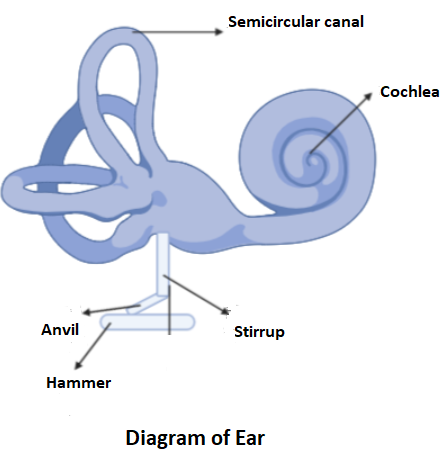
Identify the three delicate bones in the middle ear.
A. Pinna, anvil and cochlea
B. Hammer, anvil and cochlea
C. Pinna, eardrum and anvil
D. Hammer, anvil and stirrup
Answer
457.5k+ views
Hint: Ears are the sensory organs that distinguish and get the sound waves and convert them into nerve impulses, and consequently help in hearing. Notwithstanding, hearing isn't the sole function carried out by the ears. In this way, the ears perform two tangible functions: Hearing, and Maintenance of body balance.
Complete answer:
Structure of human ear: Anatomically, the ear can be isolated into three particular regions; the centre ear contains three fragile bones, called the ear ossicles. The malleus, incus and stapes are the three ear ossicles. These are their Latin names, which have basic illustrative English counterparts. The malleus bone is the hammer-formed shape. Out of the three ear ossicles, the malleus is the external one. The handle of the malleus is connected to the internal side of the tympanic layer. Incus bone lies in-ear ossicles and is connected to malleus on the external side and to stapes on the internal side. The incus bone is iron block moulded (anvil shaped) (blacksmith's iron is an instrument regularly utilized by shoemakers). The third in the line of this chain of bones is the stapes which is stirrup-moulded.

The vibration of the eardrum vibrates these bones and passes the vibrations to the cochlea. These are the smallest bones in the human body which are engaged with the conference system.
Hence, the correct answer is option D.
Note: Ear acts as the tangible or the sensory organ of the body, alongside eye, ear contains receptors that aid in hearing. The ears additionally keep up body equilibrium to maintain harmony. It changes vibrations that occur and help them to reach the cerebrum.
Complete answer:
Structure of human ear: Anatomically, the ear can be isolated into three particular regions; the centre ear contains three fragile bones, called the ear ossicles. The malleus, incus and stapes are the three ear ossicles. These are their Latin names, which have basic illustrative English counterparts. The malleus bone is the hammer-formed shape. Out of the three ear ossicles, the malleus is the external one. The handle of the malleus is connected to the internal side of the tympanic layer. Incus bone lies in-ear ossicles and is connected to malleus on the external side and to stapes on the internal side. The incus bone is iron block moulded (anvil shaped) (blacksmith's iron is an instrument regularly utilized by shoemakers). The third in the line of this chain of bones is the stapes which is stirrup-moulded.

The vibration of the eardrum vibrates these bones and passes the vibrations to the cochlea. These are the smallest bones in the human body which are engaged with the conference system.
Hence, the correct answer is option D.
Note: Ear acts as the tangible or the sensory organ of the body, alongside eye, ear contains receptors that aid in hearing. The ears additionally keep up body equilibrium to maintain harmony. It changes vibrations that occur and help them to reach the cerebrum.
Recently Updated Pages
Master Class 9 General Knowledge: Engaging Questions & Answers for Success

Master Class 9 English: Engaging Questions & Answers for Success

Master Class 9 Science: Engaging Questions & Answers for Success

Master Class 9 Social Science: Engaging Questions & Answers for Success

Master Class 9 Maths: Engaging Questions & Answers for Success

Class 9 Question and Answer - Your Ultimate Solutions Guide

Trending doubts
What are the elders in Goa nostalgic about class 11 social science CBSE

Define least count of vernier callipers How do you class 11 physics CBSE

Write the differences between monocot plants and dicot class 11 biology CBSE

Which of the following is not a feature of the election class 11 social science CBSE

The mass of oxalic acid crystals H2C2O42H2O required class 11 chemistry CBSE

How many squares are there in a chess board A 1296 class 11 maths CBSE




